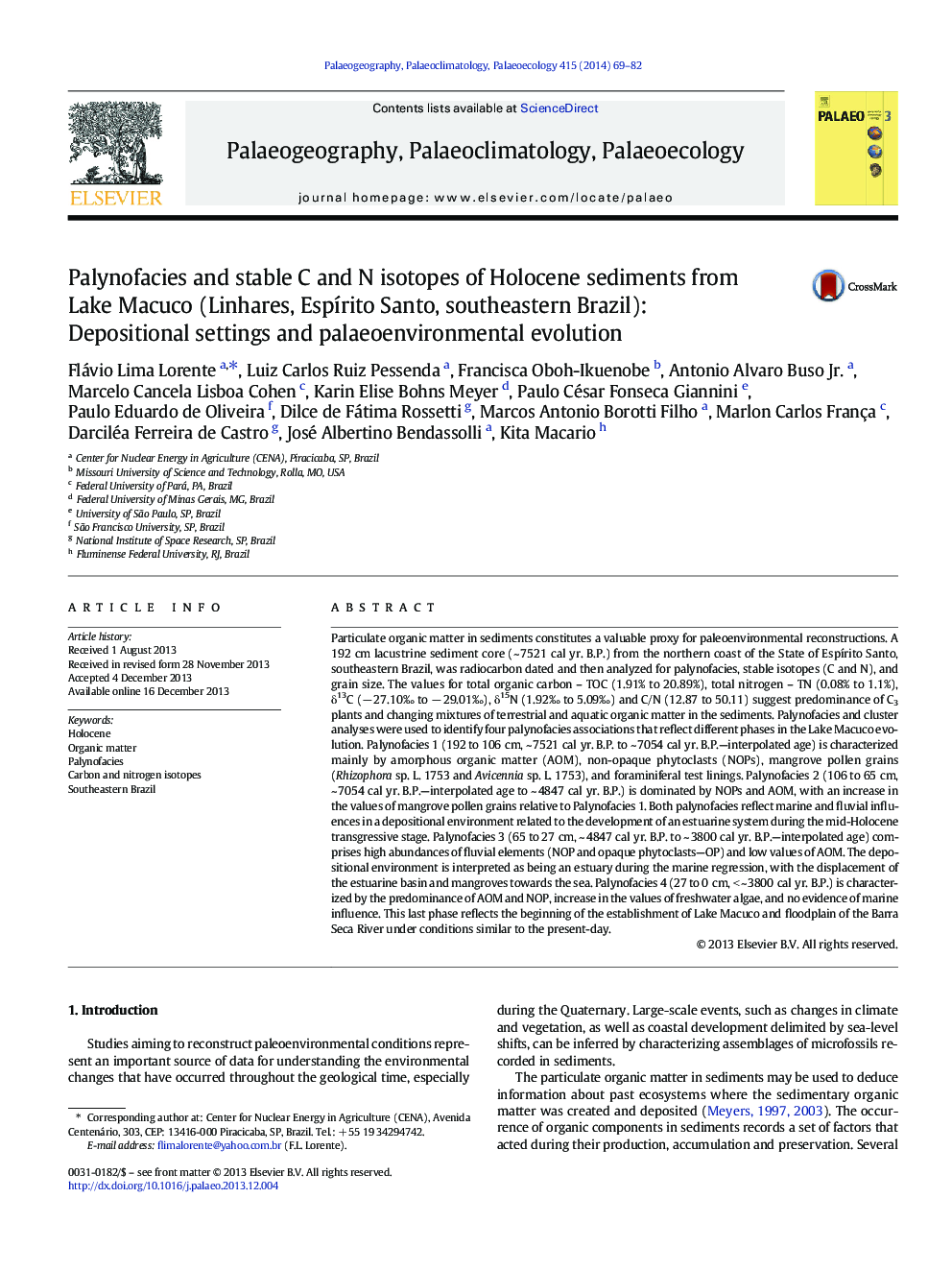| کد مقاله | کد نشریه | سال انتشار | مقاله انگلیسی | نسخه تمام متن |
|---|---|---|---|---|
| 4466166 | 1622175 | 2014 | 14 صفحه PDF | دانلود رایگان |

• A lake in southeastern Brazilian coast was studied by palynofacies, δ13C, δ15N and C/N.
• An estuarine system occurred between 7.5 and 3.8 k cal yr. B.P.
• Over the past 3.8 k cal yr. B.P. a lake was developed.
• Transgressive and regressive events occurred in the study site during the Holocene.
Particulate organic matter in sediments constitutes a valuable proxy for paleoenvironmental reconstructions. A 192 cm lacustrine sediment core (~ 7521 cal yr. B.P.) from the northern coast of the State of Espírito Santo, southeastern Brazil, was radiocarbon dated and then analyzed for palynofacies, stable isotopes (C and N), and grain size. The values for total organic carbon – TOC (1.91% to 20.89%), total nitrogen – TN (0.08% to 1.1%), δ13C (− 27.10‰ to − 29.01‰), δ15N (1.92‰ to 5.09‰) and C/N (12.87 to 50.11) suggest predominance of C3 plants and changing mixtures of terrestrial and aquatic organic matter in the sediments. Palynofacies and cluster analyses were used to identify four palynofacies associations that reflect different phases in the Lake Macuco evolution. Palynofacies 1 (192 to 106 cm, ~ 7521 cal yr. B.P. to ~ 7054 cal yr. B.P.—interpolated age) is characterized mainly by amorphous organic matter (AOM), non-opaque phytoclasts (NOPs), mangrove pollen grains (Rhizophora sp. L. 1753 and Avicennia sp. L. 1753), and foraminiferal test linings. Palynofacies 2 (106 to 65 cm, ~ 7054 cal yr. B.P.—interpolated age to ~ 4847 cal yr. B.P.) is dominated by NOPs and AOM, with an increase in the values of mangrove pollen grains relative to Palynofacies 1. Both palynofacies reflect marine and fluvial influences in a depositional environment related to the development of an estuarine system during the mid-Holocene transgressive stage. Palynofacies 3 (65 to 27 cm, ~ 4847 cal yr. B.P. to ~ 3800 cal yr. B.P.—interpolated age) comprises high abundances of fluvial elements (NOP and opaque phytoclasts—OP) and low values of AOM. The depositional environment is interpreted as being an estuary during the marine regression, with the displacement of the estuarine basin and mangroves towards the sea. Palynofacies 4 (27 to 0 cm, < ~ 3800 cal yr. B.P.) is characterized by the predominance of AOM and NOP, increase in the values of freshwater algae, and no evidence of marine influence. This last phase reflects the beginning of the establishment of Lake Macuco and floodplain of the Barra Seca River under conditions similar to the present-day.
Journal: Palaeogeography, Palaeoclimatology, Palaeoecology - Volume 415, 1 December 2014, Pages 69–82